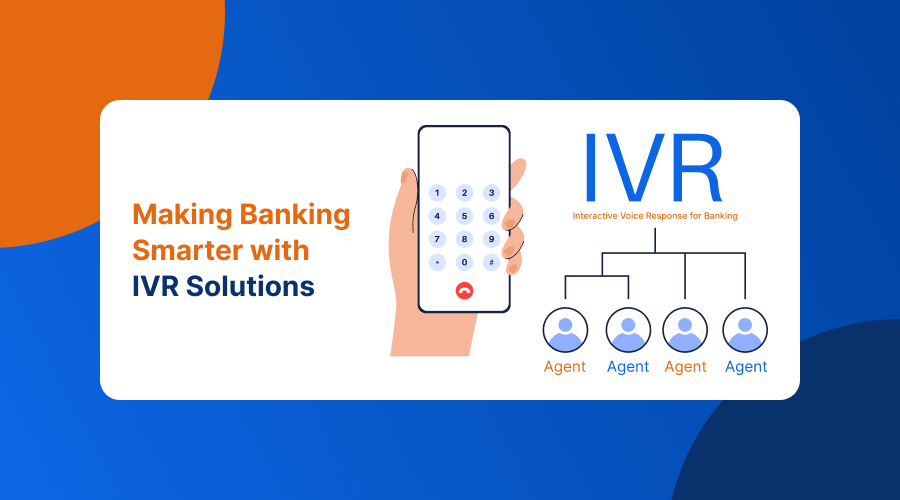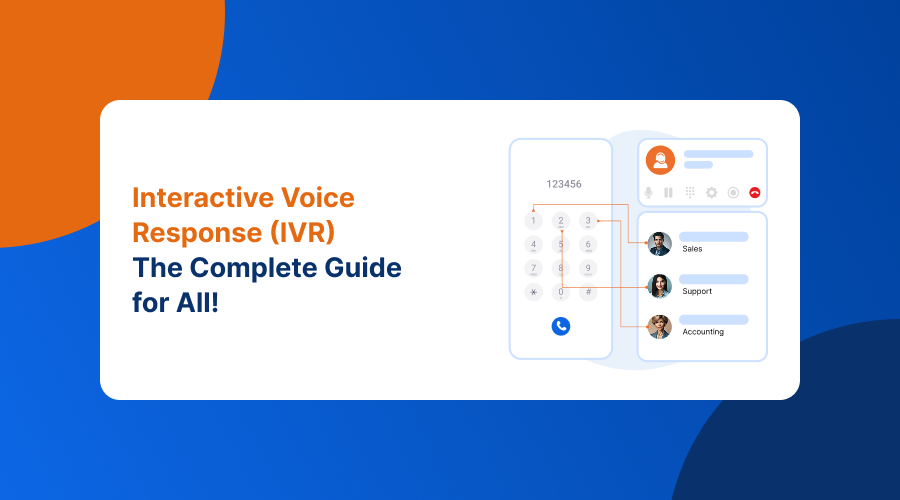In today’s fast-paced world, banking customers expect instant, round-the-clock access to services without waiting in long queues or rushing to a branch. Interactive Voice Response (IVR) systems in banking bridge that gap — automating routine queries, guiding customers through secure self-service, and freeing human agents to focus on complex tasks.
What Is IVR in Banking?
“IVR” stands for Interactive Voice Response — a telephony technology that lets callers interact with a computerized system by pressing keys or speaking simple voice commands. In a banking context, IVR enables customers to access services (check balance, transfer funds, block cards, etc.) over the phone without needing to speak to a live agent.
How Does an IVR System Work in Banking?
Here’s a step-by-step view of a typical banking IVR call flow:
- Caller Dials Bank’s Number – The IVR system picks up.
- Greeting & Prompt – “Welcome to ABC Bank. How may we assist you today?”
- Menu Options Presented (by voice or keypad) – e.g.
- “Press 1 for account balance”
- “Press 2 for recent transactions”
- “Press 3 to report lost/stolen card”
- “Press 0 to speak to an agent”
- User Selection – The caller selects via keypad or voice command.
- Backend Processing – The IVR validates caller identity (e.g. via PIN, security Qs, voice biometrics) and fetches or executes the requested action by interfacing with banking systems.
- Provide Response or Route – The system replies (e.g. “Your balance is ₹25,000”) or routes to a live agent if needed.
- Option for More Help or Exit – The caller is offered additional options or the call is ended.
For More Information Checkout Fino Payments Bank Case Study.
Everyday Banking Made Simple with IVR
- Checking account balances
- Reviewing recent transactions
- Blocking lost or stolen debit/credit cards
- Requesting new cheque books
- Transferring money between accounts
- Paying utility or credit card bills
- Changing ATM PINs
- Reporting suspicious activity
- Connecting with a customer service agent for complex issues
How Customers Benefit from IVR?
- Convenience Anywhere: Access banking services from home, office, or on the go.
- Time Efficiency: Get tasks done quickly without long waits.
- Multilingual Support: Many IVRs offer regional languages, making banking easier for everyone.
- Confidence for All Users: Elderly or less tech-savvy customers feel comfortable using phone banking instead of apps.
Key Use Cases of IVR in Banking
Below are the most valuable, commonly deployed use cases in banking IVR systems:
| Use Case | Description & Benefits |
|---|---|
| Balance / Transaction Enquiry | Customers can instantly check balances, recent transactions, check status of cheque clearance, etc. |
| Fund Transfers and Bill Payments | IVR lets users perform intra-bank or inter-bank transfers, make bill payments, and schedule recurring payments. |
| Report Lost / Stolen Cards | A critical use — customers can immediately block a lost or stolen debit/credit card and request a replacement. |
| Fraud Alerts & Notifications | Banks can trigger outbound IVR calls to alert customers of suspicious activity or validate unusual transactions. |
| Check Application / Request Status | Customers can check the status of loan, credit card, insurance, account opening applications via IVR. |
| Service Requests / Updates | e.g. update address, change mobile number/email, update communication preferences — processed via IVR. |
| Post-call Surveys / Feedback | The IVR can prompt for customer feedback immediately after interaction. |
These use cases reduce dependency on live agents for routine tasks, minimize wait times, and enhance customer satisfaction.
Key Benefits of IVR in Banking
IVR (Interactive Voice Response) has become an essential tool for modern banking. It benefits both banks and their customers in several ways:
1. Round-the-Clock Banking
Customers no longer need to wait for branch hours. IVR allows them to check balances, track transactions, or manage basic services at any time — day or night.
2. Speedy Customer Service
By automating common queries, IVR helps customers get instant answers without waiting for a representative, reducing call center congestion.
3. Secure Transactions
IVR systems can handle authentication, such as PIN verification or answering security questions, ensuring that customer information stays protected.
4. Improved Customer Experience
Quick responses and the ability to solve problems over the phone lead to happier, more satisfied customers.
5. Reduced Wait Times / Faster Resolutions
Callers can self-serve without waiting in queue; complex cases get routed faster to the right agent.
6. Scalability and Handling Peak Load
IVR systems can handle surges (e.g. during festival seasons, financial year-end) better than human-only support.
7. Better Customer Insights & Analytics
8. Consistent & Uniform Experience
9. Multilingual Support & Personalization
Offering menu choices in multiple languages improves accessibility for a diverse customer base. Personalization (greeting by name, predictive suggestions) enhances the user experience.
Tips & Best Practices for Banks To Use IVR
To make your banking IVR easy to use and effective, follow these simple guidelines:
1. Keep Menus Short and Simple
Limit the number of options so customers don’t get confused. Avoid long, complicated menus.
2. Use Clear, Friendly Language
Speak in a natural, easy-to-understand tone. Avoid banking jargon that may confuse callers.
3. Let Callers Interrupt (Barge-In)
4. Always Offer “Talk to an Agent”
Even if your goal is automation, customers should have the option to reach a real person easily.
5. Avoid Repeating Information
Don’t ask for the same details more than once. Use caller data and system integration to make it faster.
6. Route Calls Intelligently
Direct callers to the right department or agent based on their needs, so they get help quickly.
7. Provide Callback Options
Instead of keeping callers on hold, offer them the option to receive a callback when an agent is available.
8. Monitor and Improve Regularly
Track how people use your IVR and adjust menus, prompts, and call flows to make it better over time.
9. Test Often
Regularly test your IVR system to ensure it works smoothly across languages, devices, and call volumes.
10. Use AI or Voice Recognition (Optional)
Modern IVRs can understand natural language so callers can speak requests instead of navigating menus.
Conclusion
IVR systems are no longer just cost-saving automation — they’re a critical interface that defines a customer’s perception of your bank’s accessibility and efficiency. When designed thoughtfully, an IVR in banking enables 24/7 self-service, fast routing, robust security, and continuous insights — all while reducing operational burden.





